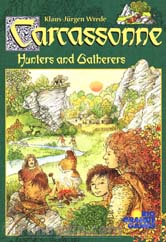
|
| Courtesy of Funagain Games |
This article provides a chart of the available tiles to help you play the game. Unlike the previous tile charts for Carcassonne and Carcassonne: The Expansion, Hunters and Gatherers has many more slight variations in the tiles. Most of the variations from the symbols that I call region decorators. A region is defined as any portion of the tile on which a single scoring piece (a "meeple") may be played. A decorator is a symbol placed in one of those regions usually to affect scoring. The original Carcassonne game has only one decorator, the shield, which adds a point to the city scoring. The Expansion had the inn-on-the-lake decorator which turns roads into double or nothing scorings. Hunters and Gathers has the following decorators:
Each row has a loose theme. The first two rows contain no rivers. The last row contains no forests. The third row contains one river edge. The fourth and fifth rows contain two river edges. As you move from left to right, in general there are more forest edges.
There are several complications in making a compact tile distribution chart. One of the difficulties is handling similar tiles with different decorators. For this chart I have grouped tiles with the same edge features into one square on the chart. Thus, the first square on the chart contains tiles with three meadows and one forest edge. However, if you click on the first image repeatedly to view the 4 tile variations (this feature requires that your browser have JavaScript enabled), you will see different animals in the meadows. Organizing tiles by edge features allows you to decide whether there are any tiles left to help you complete a scoring area.
 Another difficulty is distinguishing the special tiles which may or may
not come into play.
The special tiles are distinguished via the "+" (plus sign).
So the first square shows "3+1" which means that there are 3 regular tiles
and 1 special tile of this type.
The special tiles also have a tiny gold nugget symbol superimposed
at the bottom of the tile.
The start tile is a special case. It has the "+1" designator, but no
special symbol. It is the default tile shown in row 3 column 3.
Another difficulty is distinguishing the special tiles which may or may
not come into play.
The special tiles are distinguished via the "+" (plus sign).
So the first square shows "3+1" which means that there are 3 regular tiles
and 1 special tile of this type.
The special tiles also have a tiny gold nugget symbol superimposed
at the bottom of the tile.
The start tile is a special case. It has the "+1" designator, but no
special symbol. It is the default tile shown in row 3 column 3.
Although some of the square appear to be variations, they actually contain quite different tiles. For instance, the last image (sixth row, sixth column) contains tiles with 4 river edges. One tile has a fully connected central lake. The other tiles have curving rivers and no central lake. Although they will fit in the same square, these tiles will play completely differently. Similarly, the first and second rows, each column has the same edge features, but a different play result. For instance, the first row, first column will continue a meadow, but the second row, first column will play in the same area, but will divide a meadow.
There is also an easy-to-print version of the chart. This link contains no verbiage or navigation. Unfortunately, when you print the chart you will not be able to see all the variations. You may however click through the tiles and print a chart your favorite tile variation
Finally, if there are errors or you have come up with a nice compact, well-organized chart, please let me know. As always, I welcome any feedback on this page or the site.
Other Carcassonne related links on this site include:
Lost Tiles of Carcassonne article.
Carcassonne Review.
Carcassonne Expansion Review.
Easy-to-print Carcassonne Expansion tile distribution.
Easy-to-print Carcassonne:Hunter and Gatherers tile distribution.
![]()